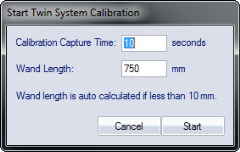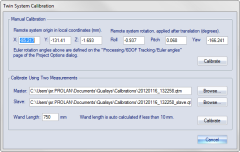Performing a Twin calibration
When using Twin systems it is necessary to specify the relations between the coordinate systems of the Twin master and Twin slave systems. Therefore the two systems must first be calibrated separately with wand calibration. The twin calibration is then created to transform the Twin slave data to the coordinate system of the Twin master. The relations are usually established in a Twin calibration procedure. However it can also be entered manually if actual relations are not critical.
If the two systems share any volume it is recommended to place the L-frame for the calibration there. Then you do not need to transform the Twin slave data at all, since the two systems share the same coordinate system definition.
Preparations
To perform a Twin calibration you need to first make sure that you have made the following preparations.
-
Set up the two systems so that the Twin master controls the Twin slave, see chapter How to use frame synchronized twin systems with separate volumes. And make sure that both systems are calibrated.
-
Make sure that you have a wand that reaches between the two volumes. It is recommended to use one where you know the length, but you can also use one of the systems to measure the wand during the twin calibration.
-
Make sure that the plane between the two systems are as large as possible. Since a larger plane will give a more accurate twin calibration.
Performing a twin calibration
Follow this procedure for the twin calibration:
-
Start a measurement with Ctrl+N on the Twin master system.
-
Click on Calibrate Twin Systemon the Capture menu.
-
Enter the Wand length and the number of seconds needed to at least move the wand in the whole plane twice.
If you don't have a wand length you can enter 0 and then make sure that both markers are clearly visible in one of the systems when you start the twin calibration.
-
Click on Start and wait for the systems to synchronize. The twin calibration is always done at Twin slave frequency, so the Twin master system might need to synchronize before you can start.
-
Press the trigger button to start the twin calibration and start moving the wand.
-
Move the wand so that you have one marker in each volume. The twin calibration will be better if you fulfill these requirements:
-
Try to move it so that you cover the whole plane between the two volumes.
-
Move the wand at least twice in the whole plane.
-
Make sure that the angle of the wand differs when you move it around in the volumes.
-
-
When finished the Twin slave data is transferred automatically and then you get the result of the calibration. Make sure that the wand length is close to what you have entered and that the standard deviation is not much higher than the deviations of the regular calibrations.
The twin calibration fails if the wand length differs more than 1 % of the entered value. The reason could be that other markers alters the twin calibration. Open the files that are saved in the calibration folder of the project and check the 3D data. Delete any 3D data that is not the wand markers. Then reprocess the Twin calibration according to the instructions below.
-
If you want to check the actual translation and rotation of the slave data , open the Twin system page on the Twin master system and then click on Calibration.
Reprocessing a twin calibration
It is possible to reprocess the Twin calibration from the Project options dialog or in the reprocessing dialogs. Follow these steps to change the twin calibration:
-
Click on Calibration on the Twin system page to open the Twin System Calibration page.
-
Then click on Calibrate to open the Twin system calibration dialog, see chapter Twin System Calibration dialog.
-
In this dialog you can change the QTM files and wand length used for the Twin calibration.
-
The twin calibration files are saved in the Calibration folder of the current project. Open the file and retrack it if you think that errors in the tracking caused problems with the twin calibration. After you retracked the file you need to reprocess the twin calibration.
-
You cannot reprocess the twin calibration if you do not have the files created in the twin calibration. However if you make sure to save all of your data in the same project then they are always saved in the Calibration folder of that project.
-
-
Then click on Calibrate inside the Calibrate Using Two Measurements heading to reprocess the twin calibration.
You can also enter a new translation and rotation manually under the Manual Calibration heading, but it is not recommended if you want the best accuracy.


